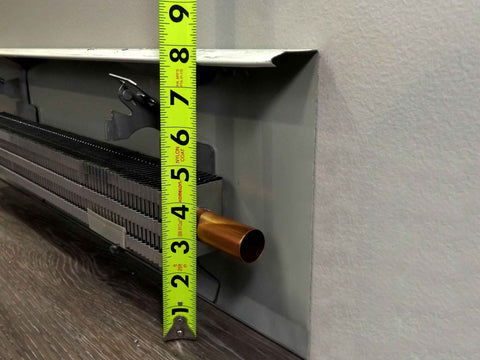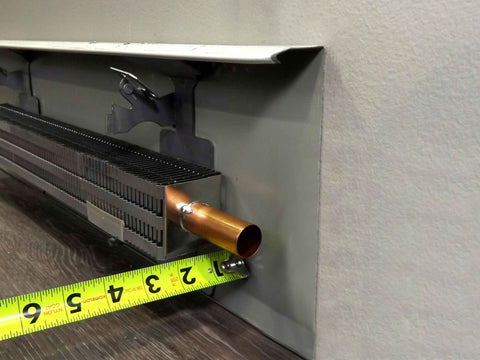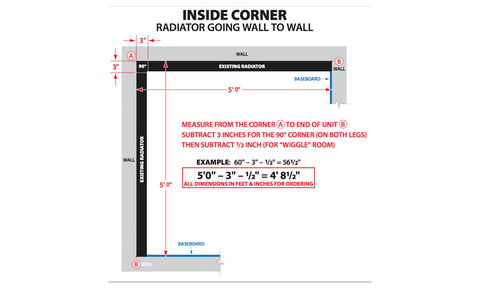Rusty baseboard heaters can silently detract from the comfort and beauty of your home. You might walk past them every day and never give them a second thought, but their presence can affect your home’s air quality and become a safety concern if left unmanaged.
Homeowners and property managers should address this issue to maintain clean, safe, and modern living spaces. Our guide explains why you should replace rusty baseboard heaters and how this home upgrade can provide immediate, noticeable benefits, transforming a room from outdated to updated in minutes.
Rust Destroys Your Home's Appeal
Rust on your baseboard heaters kills the visual appeal of any room. It screams neglect and dirty, transforming even the cleanest spaces into areas that look old and poorly maintained.
Picture this: You've just painted your walls a fresh, vibrant color and installed new flooring. That rusty, discolored metal along the baseboards immediately hijacks attention, erasing all your hard work in an instant. In addition to negatively impacting a room’s aesthetics, this corrosion can stain surrounding walls and floors, potentially requiring more extensive and costly repairs in the future.
Prospective tenants flee from rusty heaters. Property managers know this corrosion signals poor care and drives away quality renters. Homeowners face the same problem when they put their homes on the market. Buyers will immediately spot rusty fixtures and adjust their offers accordingly.
Your home's value depends on countless small details. When you ignore worn-out elements like heater covers, you chip away at your property's worth bit by bit.
New baseboard heaters are a small investment that protects your larger investment and ensures every corner of your home reflects your pride and care. Clean, rust-free heaters create a cohesive and inviting atmosphere that transforms an ordinary house into a well-maintained home.
Rusty Heaters Attack Your Health and Safety
Rusty baseboard heaters pose a threat to your family's health and safety that extends far beyond their lack of visual appeal. Rust corrodes metal and releases loose particles that float through the air.
When your heating system kicks on, it blasts these fine rust particles throughout your home. When you breathe in this contaminated air, it irritates your respiratory system—a hazard for family members with asthma, allergies, or other respiratory conditions.
Children and elderly relatives suffer the most from polluted indoor air. These microscopic metal fragments circulate continuously through your HVAC system and contaminate every room in your house.
These airborne irritants assault your lungs day after day, triggering chronic coughing, sneezing, and constant discomfort. Advanced corrosion weakens the heater cover's structure and creates sharp, jagged edges that slice curious pets or small children who play on the floor. Rust flakes accumulate on carpets and furniture, creating additional contact hazards that embed in fabric fibers.
In severe cases, the entire cover detaches from the wall, exposing scorching heating elements that burn anyone who touches them. The loose cover also creates tripping hazards. Damaged mounting brackets lose their grip strength and fall off without warning.
Corrosion Drains Your Wallet Through Energy Waste
Rust also sabotages your heating system's performance and inflates your energy bills. Baseboard heaters pull cool air from the floor, heat it with metal fins, and then push warm air into your room.
Thick rust layers smother your heater covers and internal components, trapping heat and blocking its escape into your rooms. This blockage forces your heating system to strain harder and run longer to hit the temperature you set on your thermostat. Corroded fins lose their ability to conduct heat effectively, creating dead zones where warmth never reaches your living space.
Your energy consumption skyrockets, which hammers your utility bills month after month. The problem snowballs as corrosion spreads. Minor inefficiency evolves into massive energy waste that drains your budget. Each heating cycle demands more power to compensate for your rusty baseboard heaters.
Cleaning the rust now lets your heating system work as designed. Clean, well-maintained baseboard heaters unleash optimal airflow and heat transfer. Your rooms will heat faster, and your system runs more efficiently. This simple fix slashes your energy bills immediately—a smart financial move that pays for itself and improves your home's visual appeal.
Why Cleaning and Painting Rusty Metal Wastes Your Time
When looking at those rusty baseboard heaters, you might think, "I'll just clean them up and slap on some paint." Stop right there. This simple DIY project will devour your weekend and deliver disappointing results.
Paint slapped over rust creates a temporary bandage at best. Corrosion will continue to spread underneath your fresh paint, causing it to bubble, flake, and peel within months. You must strip every speck of rust first—a messy, exhausting ordeal.
Here’s what most likely will happen.
- - You'll spend hours scraping away oxidized metal while rust dust coats everything in the room. It’ll be necessary to have proper ventilation, masks, and goggles to avoid breathing toxic particles.
- - You’ll need to use harsh rust converters and inhibitors that require protective gear and steal hours of your day as you wait for them to dry and cure between applications.
- - After you’ve prepared the surface, you must apply a special metal primer, followed by at least two coats of high-heat enamel paint that withstands temperature changes.
This multi-step nightmare consumes your entire weekend and delivers uneven, amateur-looking results. Worse yet, the rust will most likely creep back within months. Why waste hours on a solution that fails quickly when you have a better option?
Transform Your Heaters in Minutes With Snap-On Covers
Skip the weekend warrior routine. The smartest way to avoid rusty baseboard heaters involves zero tools, zero mess, and zero professional help. Snap-on covers, such as EZ Snap Covers, prevent this problem in minutes, not days.
These baseboard heater covers slip directly over your existing baseboard units and will help to prevent rust and outdated designs. We craft them from durable, high-quality materials that resist rust and discoloration forever. You choose from various styles and colors that match your home's decor, transforming functional eyesores into sleek design elements.
Installation is easier than you think: Measure your existing heater, order the correct size, and snap the new cover into place. No mess. No fumes. No waiting for the paint to dry. This approach addresses the aesthetic issue and covers sharp, corroded edges for enhanced safety.
When you consider why you should replace rusty baseboard heaters, this modern preventative solution wins hands down. You get a quick, affordable upgrade that enhances your home's beauty, safety, and value, without ruining your weekend or sanity.























